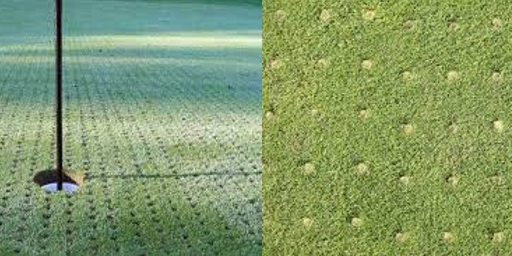What Is Hollow Tining For?
The hollow tining of greens, tees and even fairways is an essential part of most golf course maintenance programes.
It’s a recognised and proven technique carried out every year at most golf courses.
But at those clubs you’ll hear Members and Guests moaning of the holey putting surfaces.
Here we give you the lowdown on what hollow tining is and why it is an absolute must at least once a year.
So what is hollow tining?
It’s the physical removal of cores of turf from a playing surface. The holes are generally 13-16mm in diameter and of varying depths depending on the reason for the tine.The cores are ejected, swept up and removed. They make excellent compost.
When completed, a smaller mass of soil will occupy the same area of green/tee/fairway.
Why is it done?
Course traffic and maintenance practices cause the ground to become compacted and hardened.
This means drainage is less efficient and the grass’s roots are prevented from absorbing oxygen.
Hollow tining allows the compacted turf to expand and air and moisture to be more easily absorbed.
The coring helps address the problem of thatch. (Thatch is a layer of grass stems, roots, and debris that settle and accumulate over time.)
A thin layer is acceptable but too much thatch will hold water like a sponge.
Tining also removes accumulated fibre in the grass’s root zone. It allows for the exchange of a poor soil for a better one through top
dressing.
That’s why the greens are normally covered in sandy top dressing immediately after they’re cored.
When is it done?
Hollow tining is generally done between August and September as the temperatures allow for quicker recovery of surfaces and also prepare the greens for the rain season by improving drainage.
It’s important that the tining is completed before the weather turns wet so there’s time for growth and for the holes to seal up.
So the best time to hollow tine is late August/early September.
Is it a treatment for diseased greens?
It’s generally accepted that drier surfaces will be less susceptible to diseases like fusarium.
As hollow tining is a good way of improving drainage it’s also a way of preventing the spread of disease.
Is it just for greens?
It’s a potential treatment for any turf suffering from compaction and the other conditions explained above. Many courses hollow tine their tees and, if they have the manpower, some will even hollow tine the fairways.
Is solid tining the same thing?
Not quite. Solid tining doesn’t go as deep as hollow tining. It’s useful for aerating the upper level of the root zone but it won’t relieve the problem of compaction.
It can be carried out at any point through the year and is particularly good where there is sandy soil that doesn’t need much compaction relief.
What about slitting, scarifying and verticutting?
Slitting is another method of aerating the turf and counteracting thatch.
Deep slitting is normally carried out through the winter when the ground is softer and more receptive.
It’s done with blades that penetrate from 125 to 300 mm. These will be attached to a machine pulled by a tractor.
You’ll normally see this treatment on the fairways. Surface slitters penetrate just 40mm.
These are designed to keep the surface open during the summer months aiding water percolation.
Scarifying is a way of physically removing thatch using heavy-duty vertically mounted blades. Verticutting controls thatch build up by vertical mowing.
Visit from the Matkovich group
Louis van der Walt a representative of the Matkovich group and our course designer visited us recently. The reason for his visits was to look at areas that can be improved without changing the his original vision of the golf course. Over the next couple of months our main area of focus and will be improving on the green surrounds. In some areas there is some subtle changes to be made to the apron lines, and in other areas there is some smoothing and leveling to be worked on to ultimately improve the golfing experience.
With the events center under construction, we have also agreed on changing the orientation of the driving range to stop balls going into that area.
Some work will also be done along the left side of hole 1 and hole 2 to ensure that the hotel fits in well with the golf course.
Other areas that were discussed were possible additions of more tees to create even more variety week in week out.
Yours in Golf,
Shiraz Mirza – Bonanza Golf Course Green Keeper






